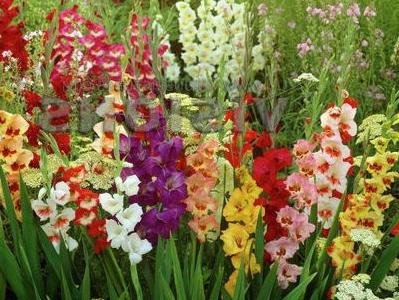Gladioli are flowering plants from the iris family. They are photophilous; they prefer moderately moist, breathable soils. Bloom from July to October, depending on the variety. The height is divided into medium-sized (from 50 to 100 cm) and tall (more than 100 cm).
To get a luxurious gladiolus, its landing must be correct. These plants are not the most difficult to grow. But the need to dig bulbs every autumn, disinfect, dry and store until the next spring lazy people discourage the desire to cultivate them. However, having once grown beautiful gladioli, there is a need to acquire bulbs of new varieties in order to admire their flowering.
Proper planting of gladioli includes preparing bulbs for planting. This stage is very important. Corms need to be taken out of the store 25 days before planting, brought into a heated room in which the temperature is 20-25 0 C. It is necessary that the air humidity is low so as not to provoke strong root growth.
As a rule, at the end of winter, the gladiolus ends with a dormant period and the bulbs begin to germinate in any conditions. As soon as the shoots appear, corms need to provide sufficient diffused lighting. They need to be cleaned of covering flakes, especially for children.
If the gladioli should be planted with a small number of bulbs (or this is a particularly valuable variety), and they have foci of rot damage, then you can try to save them. With a sharp knife treated with alcohol or fire, it is necessary to cut out the decayed area, grabbing healthy tissue. It is imperative to grease the cutoff points with something, for example, brilliant green. At this point, a caked layer of tissue forms in a week, which will prevent infection, i.e. during the next 7 days, such bulbs can not be planted.
If planting material was stored in a refrigerator, then it needs heat treatment, such as heating in warm water at 25-30 0 C. This will give corms a good incentive, accelerate their further development and flowering.
Planting gladioli is carried out after disinfection from fungal spores and thrips. For this, special preparations or infusions on phytoncid plants are used. Of the drugs, you can use baseazole 0.3% or phytosporin. Bulbs are placed in the prepared solution for 40 minutes. You can cook an extract from thrips: juice is squeezed out of 100 g of garlic, diluted in 1 liter of water. Bulbs are placed in such a solution for 3 hours.

Best of all, gladioli grow on specially prepared ridges, where humus, sand or sawdust was brought in from the fall under digging. Planting pattern depends on the size of the bulbs and the purpose of cultivation. Rows are marked after 30 cm, the distance in the row between the bulbs is about 10 cm. The depth of the groove for large specimens is from 10 to 15 cm. The bulbs are bottom-down, they cannot be pressed into the soil. For tall varieties, it is advisable to immediately establish supports for tying. Purified children are planted according to a 3x3 or 4x4 cm pattern by analogy with
onion sets. The embedment depth is small - about 3 cm. If the earth is wet, then you do not need to water it: this way it will remain more loose. After you have placed gladioli in the soil, the landing should be sprinkled with sand.
If a small number of bulbs of different sizes are planted, then they are conveniently placed in the holes. In one dug hole, you can put 3-4 medium onions to the maximum depth, several small ones - less deep, a few children - closer to the surface. Such planting of gladioli does not require support: it is enough to tie the plants into a bouquet.